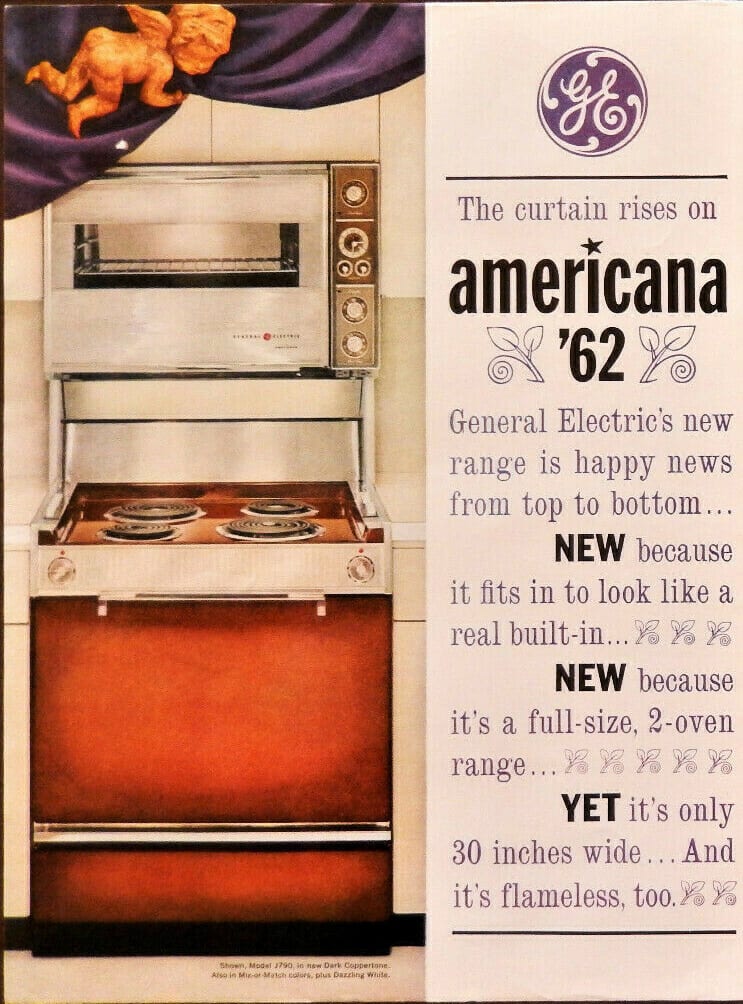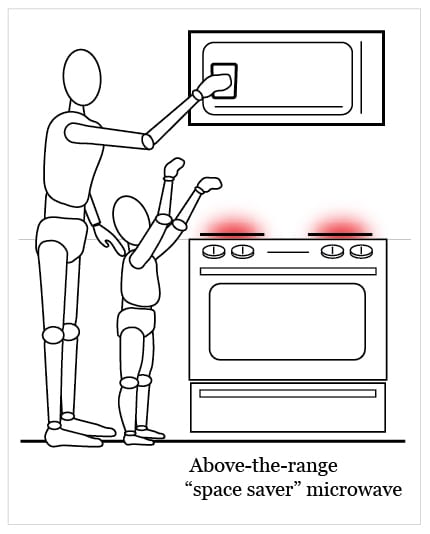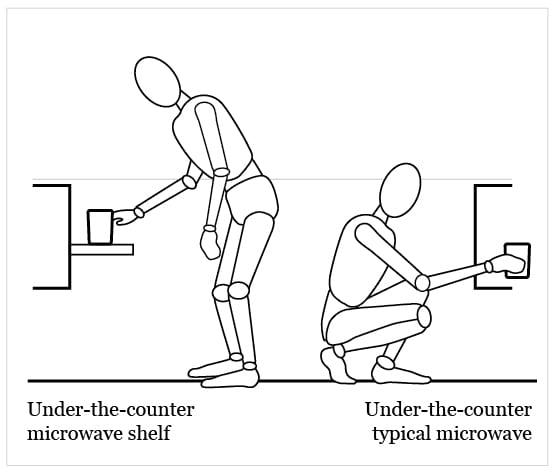Why would you invest a thousand dollars or more on an in-drawer microwave when you can purchase a perfectly serviceable countertop or above-range microwave for a few hundred dollars?
That’s what we’re here to find out!
Over the past three years, no appliance has attracted more client attention than the microwave drawer. Despite the cost, homeowners love the any-age ergonomics, flexible installation options and the fully-integrated aesthetics.
A Brief History of the Microwave oven and Its Location in the Kitchen.
Most microwaves are located on a countertop, or above a range. Countertop microwaves really are a hold-over from the early days of the appliance and its substantial size. The first mass-produced microwave oven, the Amana Radarange was so large that it needed the full 25” width of a standard countertop.
As the popularity of microwaves exploded, a whole new furniture category built around the storage of bulky microwave ovens was created to accommodate the large box.
As microwave technology advanced, and the size of the magnetron and other working parts decreased, appliance manufacturers looked for ways to give back some of the precious countertop space that early microwaves had taken.
Jim Hoetker, Industrial Designer for the GE Range Department, was tasked in the late 1960’s with finding ways to not only reduce the size of microwave ovens, but also to integrate the microwave into the popular GE Americana line of ranges with double ovens.
In the 1960’s GE had a popular line of dual oven appliances with one oven attached by a metal “belly band” above the cooktop to a second oven that was perched on top of the range With the nascent market of the microwave set to explode, GE wanted to replace the second, top oven with a microwave oven.

Hoetker’s breakthrough was imagining the above-range microwave as a stand-alone product that could be attached to the underside of upper cabinets, often above a range. Rather than replace an existing range to purchase a new GE microwave-range combo, you could simply purchase a GE Spacesaver microwave oven and install it in place of an existing range hood. Forty years later GE estimates that 1 in 4 homes has a “Spacesaver” microwave attached above the range.
Few Widely Adopted Innovations in the Past Two Decades
As the commercialization of the microwave oven reached nearly six decades, appliance manufacturers have added a few well-received features such as digital controls and automatic re-heating. On the other hand, added features such as convection, steam and “browning” never really took hold and that’s because of the reality of how most people use a microwave. Simply put, consumers use the microwave to reheat food well over 90% of the time.
With so little innovation over the past two decades, could the microwave drawer be the new microwave feature that consumers adopt?

Aesthetics and Ergonomics Drive Interest in the Microwave Drawer
As kitchen design has moved towards a clean, uncluttered look, homeowners have demanded more countertop space and upper cabinet storage. Other than physically increasing the size of the kitchen, the simplest way to achieve this is to place the microwave in the base cabinetry.
More importantly, the ergonomics of the microwave have always been a challenge for young children and increasingly the independent elderly who are choosing to stay in the home. The location of the microwave above a range or even on a 36” high cabinet leaves the young children searching for a chair to stand on. Not an ideal situation with hot food in hand!

Side-Opening Microwave Doors Create Their Own Challenges
While conventional microwaves can fit in base cabinetry, the side-opening door is awkward to use below waist level. The side-open door requires that the user bend down not only to place food in the microwave, but to actually see into it and use the control panel. (Image)
The microwave drawer solves these problems. With the push of a button on the top of the drawer face, the drawer smoothly opens allowing you to place both food or drink down directly onto the tray without having to bend awkwardly down. (Image)
All microwave drawers are manufactured by Sharp which owns 11 patents on the device. While the first of the patents was filed in 1987, the original design imagined a clumsy dome-like structure that was manually pulled out like a drawer. (image)
Over the years, this design was refined to eliminate the plastic dome and the movement of the drawer was motorized, creating an easy-to-use and ergonomically friendly appliance.
By moving the microwave to the base cabinetry, access to the microwave becomes safe and easy for young and old alike.

When Price Becomes an Object
There are a couple of challenges facing the microwave drawer, but the most obvious is the price. Because of the Sharp patent holdings and the more complex nature of the motorized drawer slide, the entry level price for a microwave drawer is still over a thousand dollars.
For many, the difference between a fully-featured traditional microwave at $400 and the microwave drawer at $1,100 is too much to bear. However, when you consider that the microwave drawer makes one of the most frequently used appliances accessible to all members of a household, the investment is often worth it.
- Charge Your Phone or Your Kitchen Dreams? The Freepower.io - June 21, 2025
- Why NKBA Design Certifications Matter A lot, Until They Don’t - September 3, 2024
- 2024 Kitchen & Bath Design Trend: Texture - April 9, 2024

